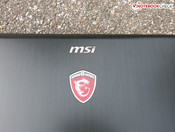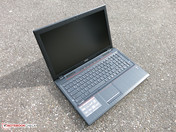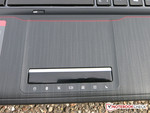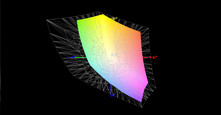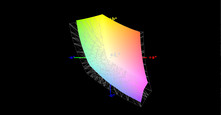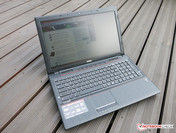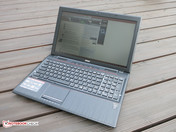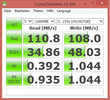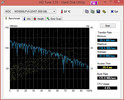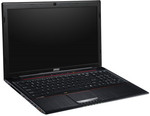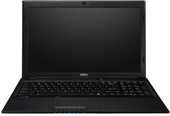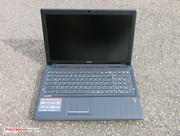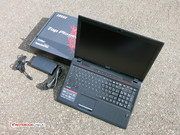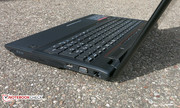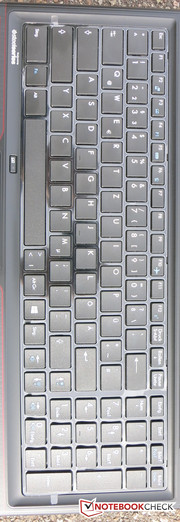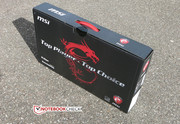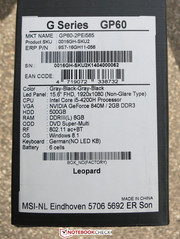MSI GP60-2PEi585 Notebook Review

For the original German review, see here.
The MSI GP60-2Pei585 is almost a 15-inch replica of the MSI GP70 Leopard already reviewed by us. Both models feature Nvidia's new 840M graphics card and Intel's i5-4200H processor. The GP60 is optionally also available with an i7 quad-core CPU. In the 17-inch device, the cons were the case with its poor build quality and the somewhat slow hard drive. The pros were the bright display with wide viewing angles and temperature and noise emissions.
We compare our test device to the Asus F550LN-CN89H and Lenovo IdeaPad Y510p. The Asus also features an Nvidia 840M, but the processor is a more frugal, yet more powerful Intel i7-4500U. Meanwhile the price of the Lenovo fell to about the MSI GP60's. A slightly different model to the one we reviewed, even comes with an Intel Core i7-4700MQ quad-core CPU and an Nvidia GT 755M.
Could the GP60 even be a perfect alternative to bulky gaming notebooks or weak devices from the entry-level or mid-range segment? Our review will clarify whether MSI could avoid the points of criticism in the smaller brother and keep the aforementioned advantages.
Case
Despite a price of about 800 Euros (~$1087), MSI used a plastic case. While the build quality is appropriate, the plastic does not seem very robust. Especially the underside is very thin. Looking closer, the material on the upper side gives it a rather cheap appearance. It is thus not surprising that the notebook can be slightly twisted and even slightly depressed with relatively low force. The notebook should definitely be stiffer.
The gaps are consistently very good for a notebook made from plastic. In addition, the surfaces are not reflective and, so, not prone to grease and fingerprints. Only the lid is slightly more susceptible to these. Opening the notebook with one hand is almost impossible, since the base unit lifts following the slightest opening angle. The size is rather bulky, although it is not a genuine gaming notebook. Especially the height is reminiscent of "old times". Certainly, this is primarily due to the incorporated processor, which requires intense cooling under load.
Connectivity
Meanwhile, it appears to be standard that the interfaces only consist of two USB 3.0 ports, one USB 2.0 port, HDMI, VGA, Ethernet, a card reader and 3.5 mm jacks even in higher-end notebooks. Similar to the Asus and the Lenovo, the MSI does not provide more. While this might be sufficient for mainstream users, several other manufacturers deliver at least a DisplayPort or eSATA in addition.
At least the interface layout of the MSI GP60 is almost perfect. Using an external mouse does not block other USB ports and the Ethernet port cannot be covered by a connected USB device. Unfortunately, you do have to fumble around looking for the card reader on the front side.
Communication
WLAN 802.11ac and a Bluetooth V4.0 module are standard features of the GP60. We experienced no connection issues up to two floors away from the router. This range is impressive. The Killer Gigabit Ethernet port allows wired connections. The webcam produces 720p images, which is acceptable for a notebook.
Operating system
Our GP60 test model comes preinstalled with Windows 8.1. Other models are offered without an operating system. A Windows DVD is not included. If you prefer Windows 7, you should not experience problems since MSI provides the necessary drivers on the homepage.
Maintenance
A good solution from MSI: There is a big maintenance hatch on the underside, which covers almost a third of it. Therefore, it is easy to replace the hard drive with an SSD. In addition, one of the two RAM slots is still free, allowing an easy upgrade from the built-in 8 GB to 16 GB.
Warranty
MSI grants a manufacturer's warranty of 2 years on all notebooks per default. It is possible to extend it by a year in the MSI shop, but it is rather expensive at 139 Euros (~$189). Asus charges a lot less at about 80 Euros (~$109).
Input Devices
Touchpad
The touchpad is somewhat too small with a diagonal of 9.5 cm (~3.7 inches), making it almost necessary to use an external mouse. Nevertheless, it is a precise touchpad with multi-touch support and two separate mouse buttons and not one of the currently widespread ClickPads. Unfortunately, the left mouse button often only responds on the second try. This is annoying after a while, but might be a peculiarity of our test sample. The rough surface of the touchpad feels nice to the touch and makes moving the finger easier. However, this is a matter of taste, since many users prefer a smooth touchpad surface.
Keyboard
Unfortunately, the keyboard of the GP60 does not feature a keyboard light. Many other devices in this price range and with the same field of application come with lighted keyboards and it would have been a nice feature for the GP60, too. The key travel is relatively big and the pressure point is comfortable. The stroke noise is also convincing. The keys only "clatter" a little bit along the left edge, but this is not annoying.
The good key size of 14 x 14 mm allows for fast typing. Prolific writers without computational intensive tasks should select a different device, since the numpad takes away valuable space from the QWERTY keys. The Windows 8 button was moved to the right of the space bar and the left shift key got significantly wider in order to make the keyboard gaming friendlier.
Display
MSI equipped the GP60 with a matte 15.6-inch Full HD display with a native resolution of 1920x1080 pixels. Subjectively, it is not only contrast-rich and true color, but also sufficiently bright and pin sharp. Daytimes, you will hardly need more than half the maximum brightness. In the evening or at night even, just under a third is sufficient. This is hardly surprising since the average brightness is about 209 cd/m². The Asus F550LN just achieved 166 cd/m² in our test. Nevertheless, the GP60 does not reach new levels, but is only mid-range according to our measurements. Other devices achieve values of just below 400 cd/m². With a maximum 367 cd/m², the IdeaPad Y510p definitely belongs to the best.
| |||||||||||||||||||||||||
Brightness Distribution: 77 %
Center on Battery: 228 cd/m²
Contrast: 760:1 (Black: 0.3 cd/m²)
ΔE ColorChecker Calman: 7.11 | ∀{0.5-29.43 Ø4.78}
ΔE Greyscale Calman: 8.38 | ∀{0.09-98 Ø5}
56% AdobeRGB 1998 (Argyll 1.6.3 3D)
59.5% AdobeRGB 1998 (Argyll 3D)
86.3% sRGB (Argyll 3D)
57.8% Display P3 (Argyll 3D)
Gamma: 2.22
CCT: 10041 K
The display of the MSI GP60 performs subjectively better than expected from the measurements. It only covers 56% of AdobeRGB and 78% of sRGB. The black value of 0.3 cd/m² is above average, the same is true for the resulting contrast of 783:1. As a result, deep black is possible. (Asus F550LN: black value 0.41 and contrast 424:1; IdeaPad Y510p: black value 0.65 and contrast 608:1)
| MSI GP60-2PEi585 GeForce 840M, 4200H, Western Digital Scorpio Blue WD5000LPVX | Lenovo IdeaPad Y510p GeForce GT 750M SLI, 4700MQ, Samsung SpinPoint M8 HN-M101MBB | Asus F550LN-CN89H GeForce 840M, 4500U, Seagate Momentus SpinPoint M8 ST1000LM024 HN-M101MBB | Asus N550JK-CN109H GeForce GTX 850M, 4200H, Seagate Momentus SpinPoint M8 ST1000LM024 HN-M101MBB | |
|---|---|---|---|---|
| Display | 3% | -29% | -11% | |
| Display P3 Coverage (%) | 57.8 | 59.9 4% | 40.82 -29% | 55.1 -5% |
| sRGB Coverage (%) | 86.3 | 88.4 2% | 61.2 -29% | 71.8 -17% |
| AdobeRGB 1998 Coverage (%) | 59.5 | 61.5 3% | 42.2 -29% | 53.2 -11% |
| Screen | -5% | -6% | 5% | |
| Brightness middle (cd/m²) | 228 | 395 73% | 178 -22% | 284 25% |
| Brightness (cd/m²) | 209 | 368 76% | 166 -21% | 264 26% |
| Brightness Distribution (%) | 77 | 83 8% | 81 5% | 80 4% |
| Black Level * (cd/m²) | 0.3 | 0.65 -117% | 0.41 -37% | 0.388 -29% |
| Contrast (:1) | 760 | 608 -20% | 434 -43% | 732 -4% |
| Colorchecker dE 2000 * | 7.11 | 8.9 -25% | 4.36 39% | 5.24 26% |
| Greyscale dE 2000 * | 8.38 | 10.88 -30% | 3.35 60% | 7.7 8% |
| Gamma | 2.22 99% | 2.55 86% | 2.36 93% | 2.63 84% |
| CCT | 10041 65% | 11341 57% | 6991 93% | 6119 106% |
| Color Space (Percent of AdobeRGB 1998) (%) | 56 | 39 -30% | 47 -16% | |
| Total Average (Program / Settings) | -1% /
-3% | -18% /
-12% | -3% /
1% |
* ... smaller is better
The viewing angle stability is convincing, too: In the horizontal direction, color changes only occur at very acute angles, but images stay legible. Similarly big viewing angles are possible in the vertical direction without image changes, but they appear earlier and stronger. It seems MSI incorporated an above average TN panel. As a result, it is possible to use the GP60 outdoors, but there are certainly some restrictions in direct sunlight.
Performance
MSI lists the GP60 in the gaming notebook category on their homepage. We do not agree with this because of the built-in 840M mid-range graphics card from Nvidia. Although the i5-4200H processor delivers good dual-core performance, the graphics performance is too low for absolute gaming power; even more so because of the Full HD display. Nevertheless, you can work very well with the GP60, and it is able to run all current games, although sometimes details have to be reduced.
Processor
The Intel Core i5-4200H of the new Haswell generation not only brings good processing performance with two cores and Hyperthreading, but also a high power dissipation of 47 Watts under load. Nowadays usually only powerful quad-core models require so much power. The "M" base model of the i5-4200 needs 10 Watts less under load. The standard clock of the processor is rather high with 2.8 GHz and can be automatically increased to 3.4 GHz thanks to Turbo. This is 300 MHz higher than the i5-4200M's in both modes. Both cores also share a cache of a moderate 3 GB here.
The measured performance is consistently high. Compared to the "normal" brother, running the i5-4200M (20% lower TDP), the average benchmark results of the H model are only about 12% higher. Since both processors cost the same, the decision from MSI is halfway understandable - despite higher TDP.
The single-core performance is about on par with Intel's i7-4700HQ quad-core processor in Cinebench R11.5. The frugal i5-4200U, with a TDP of 15 W, is about 20-25% slower. Not even the A10-6800K from AMD's desktop range can keep up here. It is 20% slower.
If all cores are loaded, the results are different: The AMD A10-6800K is now on par with the test model, while the i5-4200U is about 30% slower again. The i7-4700HQ is almost double as fast; four cores with Hyperthreading are definitely advantageous.
| Cinebench R11.5 | |
| CPU Multi 64Bit (sort by value) | |
| MSI GP60-2PEi585 | |
| Asus F550LN-CN89H | |
| Asus F550LN-CN89H | |
| Lenovo IdeaPad Y510p 59-395032 | |
| Asus VivoBook S451LB-CA072H | |
| Medion Akoya E6239T | |
| CPU Single 64Bit (sort by value) | |
| MSI GP60-2PEi585 | |
| Asus F550LN-CN89H | |
| Asus F550LN-CN89H | |
| Lenovo IdeaPad Y510p 59-395032 | |
| Asus VivoBook S451LB-CA072H | |
| Medion Akoya E6239T | |
System Performance
The system performance is consistently high. Especially compared to a cheap notebook, a significant performance gain is noticeable. Processor intensive tasks like unzipping files or the installation of software definitely run faster and smoother. The system boots quickly and there are no lags when using the GP60, so it is always possible to work smoothly.
With an SSD built-in ex factory, the test system would have performed even better. Although using the notebook does not really raise the wish for an even faster mass storage, our measurements say otherwise. While the system reached very good results of just above 2900 points in the PCMark 8 Home benchmark, systems with SSDs, but slower processors like the i5-4200U, can also reach these levels or even surpass them.
| PCMark 7 Score | 2953 points | |
| PCMark 8 Home Score Accelerated | 2912 points | |
| PCMark 8 Creative Score Accelerated | 3077 points | |
| PCMark 8 Work Score Accelerated | 3690 points | |
Help | ||
Storage Devices
The 500 GB mass storage device achieved above average results for a 2.5-inch hard drive compared to other test systems. It achieves maximum sequential write and read rates of just under 110 MB/s. The read rate of 512k blocks is 34.8 and the 512k write rate is 48 MB/s. Certainly the HDD cannot keep up with an SSD in terms of performance. In terms of noise, the HDD is essentially silent.
Thank to the big maintenance hatch on the underside, it is easy to replace the hard drive with an SSD. Each buyer has to decide for himself whether this is necessary, especially because there is only space for one SATA drive and so it is not possible to use both at the same time.
Graphics Card
Although MSI designed the GP60 primarily for gamers and lists the notebook in this category, it only features an Nvidia 840M graphics card. Although it is not a bad choice and its performance is about on par with the older GT750M's, it cannot keep up with Nvidia's GTX models. The 840M achieves 2500 points in 3DMark 11 and the GT750M delivers the same result, while the GTX850M achieves a whopping 4450 points giving a noticeable performance gain of about 78% for real gamers.
MSI uses an 840M with 2 GB of DDR3 video memory and a standard clock of 1001 MHz. The graphics processor with a GM108 chip clocks at a maximum of 1029 MHz and features 384 shader units and a 64-bit memory interface. If needed, the core clock is increased to 1124 MHz. In low load scenarios, only the Intel HD Graphics 4600 is in use. It is significantly slower, but very frugal. Under load, the system automatically switches to the Nvidia graphics without flickering (Nvidia Optimus).
| 3DMark 11 Performance | 2562 points | |
| 3DMark Ice Storm Standard Score | 54685 points | |
| 3DMark Cloud Gate Standard Score | 6707 points | |
| 3DMark Fire Strike Score | 1448 points | |
Help | ||
Gaming Performance
The Nvidia 840M is gaming capable in our tests! Please note, that the GP60 features a display with a resolution of 1920x1080 pixels. Best graphical results can only be achieved with this native resolution, whereas the graphics card might reach its limits in several games. As long as you are satisfied with upper mid-range settings or - depending on the game - also with high and very high settings, games run smoothly. In games like GTA4 or Company of Heroes 2, which benefit from a quad-core CPU, the processor could sometimes become a bottleneck if paired with a significantly more powerful GPU.
| low | med. | high | ultra | |
|---|---|---|---|---|
| Tomb Raider (2013) | 146.2 | 58.9 | 32.7 | 10.5 |
| BioShock Infinite (2013) | 97.3 | 54.3 | 43.41 | 14.75 |
| Metro: Last Light (2013) | 48.75 | 40.35 | 28.77 | 13.2 |
| GRID 2 (2013) | 93.3 | 77.4 | 63.2 | 20.27 |
| Company of Heroes 2 (2013) | 35.05 | 28.33 | 17.76 | 7.23 |
Emissions
System Noise
While idling, the notebook is audible, yet not too loud. The hard drive always works quietly. Under load and with increasing temperatures, the cooling system is indeed noticeable. Depending on the load, the temperature control regulates the fan discreetly. For example, when games demand more performance from the processor and graphics card, it does not take a minute until the fan noise gets louder.
MSI equipped the GP60 with a turbo cool mode called "Cooler Boost". Upon pressing the corresponding special key beneath the manufacturer's logo, the cooling system becomes a small hurricane. The fan spins significantly faster until it reaches its maximum speed. This should be especially advantageous for gamers, who want to squeeze out maximum performance from the system. However, the performance did not increase noticeably in our gaming benchmarks. Therefore, we ran the listed gaming and system noise tests without activating Cooler Boost.
Noise level
| Idle |
| 33 / 33.2 / 33.4 dB(A) |
| HDD |
| 33.4 dB(A) |
| DVD |
| 37.7 / 37.7 dB(A) |
| Load |
| 36.2 / 50 dB(A) |
 | ||
30 dB silent 40 dB(A) audible 50 dB(A) loud |
||
min: | ||
Temperature
The temperature remains in the acceptable range around 25 °C (77 °F) when idle as well as under load. Depending on the measurement point, it ranges from good 23.6 °C (74.5 °F) to acceptable 27.5 °C (81.5 °F). When the load increases and the dedicated graphics card is used, the temperatures increase to a maximum of just less than 39 °C (102.2 °F). Only in two areas, we measured temperatures of just above 40 °C (104 °F). Thanks to the powerful cooling system, the average temperature is still appropriate. With the Cooler Boost button, the values can be decreased.
(±) The maximum temperature on the upper side is 40.6 °C / 105 F, compared to the average of 36.9 °C / 98 F, ranging from 21.1 to 71 °C for the class Multimedia.
(±) The bottom heats up to a maximum of 42.5 °C / 109 F, compared to the average of 39.2 °C / 103 F
(+) In idle usage, the average temperature for the upper side is 25.9 °C / 79 F, compared to the device average of 31.3 °C / 88 F.
(±) The palmrests and touchpad can get very hot to the touch with a maximum of 36.3 °C / 97.3 F.
(-) The average temperature of the palmrest area of similar devices was 28.7 °C / 83.7 F (-7.6 °C / -13.6 F).
Speakers
MSI also emphasizes the audio technology in the GP60 and refers to a "system with stereo speakers and subwoofer […] from the high-end audio specialist Dynaudio". While the sound of the built-in speakers does not come close to a small 2.1 system, the stereo sound is balanced and powerful for a notebook. The sound does not even distort at higher volumes. Subjectively, other test systems perform significantly worse here. As a result, the audio system is not only apt for chats and Windows sounds, but also for games, videos and occasional music playback.
Energy Management
Power Consumption
The notebook profits from the fact that CPUs do not reach their TDP in this scenario when idle. The whole system, including display only turns 8 Watts into heat even with the i5-4200H. Usually only notebooks with ULV components or SoC (System on a Chip) achieve this. On average, the system only needs 13 Watts when idle.
However, the value quickly changes with increasing load. Under full load, we measure almost 75 Watts. Although this is a lot for a notebook, it is caused by the installed components including a processor with a TDP of 47 Watts, a graphics card with a maximum power consumption of about 30 Watts and a relatively bright display. The power adapter is designed for a maximum power consumption of 120 Watts.
| Off / Standby | |
| Idle | |
| Load |
|
Key:
min: | |
Battery Life
The GP60 comes with a Li-ion battery with 11.1 V and 49 Wh ex factory. As long as you do not want to play games on the move, i.e. use the components to capacity, it is even rather enduring despite power-hungry components under load. The clock rates of CPU and GPU are not limited on battery in favor of performance.
While idling, Intel's integrated HD Graphics 4600 graphics chip is used. The battery of the GP60 is empty after just above 6 hours in this scenario. The Asus F550LN has a significantly longer battery runtime of 7:17 h, but it is equipped with a ULV processor. Idle mode is simulated with the Battery Eater Reader's test, minimum display brightness, energy-saving profile and disabled wireless modules.
Our realistic WLAN test ends after only 2:50 h. In this test, web sites are automatically loaded in intervals. The energy-saving profile is active, and the display brightness is set to browsing and reading level (about 150 cd/m²). With 3:50 h, the Asus is significantly better again.
Under load, the battery is emptied quickly. A power consumption of about 75 Watts and a battery capacity of 49 Wh give a calculated battery life of 39 minutes. In the Battery Eater Classic test, the GP60 achieves a battery life of about 0:56 h with maximum display brightness, maximum performance profile and enabled wireless modules. But, the graphics card is only running at 15 % capacity under this test. Under full load, the Asus is not really better at 1:14 h, but it comes with a smaller 37 Wh battery.
Verdict
The GP60 2Pei585 Leopard is only one of many similar models with different processors and graphics cards from MSI. The used components are barely justified for a current street price of just under 800 Euros (~$1087), whereas the operating system alone costs about 100 Euros (~$136). MSI also offers a similar system with older GT740M graphics card and Intel Core i7-4700MQ quad-core CPU without OS from 600 Euros (~$815).
The used CPU/GPU combination is not truly suitable for hardcore gamers, but several games run smoothly with high settings. The performance of the system is always very high, unfortunately at the expense of a power-hungry processor. Therefore, the system should be used on a desk rather than in the garden.
The high-res, non-reflective Full HD display is noteworthy. It is not only sufficiently bright, but also contrast-rich and viewing angle stable. Its legibility outdoors is better than several of the competitors.
If you do not mind the slightly thicker plastic case and like to spend your time with slightly more demanding games, you can buy the MSI given its price. You might also consider the cheaper sister model with a graphics card of the previous generation, but faster Intel quad-core processor.





